






String trios by three uncontainable geniuses, Ludwig van Beethoven, Coleridge-Taylor Perkinson and Dame Ethel Smyth.
Laura Scalzo, violin Emily Freudigman, viola Ken Freudigman, cello
Movement for String Trio
String Trio in D Major, Op. 6

Coleridge-Taylor Perkinson (1932-2004)
Dame Ethel Smyth
Allegro (1858-1944)
Allegretto grazioso
Adagio (non troppo)
Finale: Allegro molto
— INTERMISSION —
String Trio in E-flat Major, Op. 3
Ludwig van Beethoven
Allegro con brio (1770-1827)
Andante
Menuetto: Allegretto
Adagio
Menuetto: Moderato
Finale: Allegro
APRIL 5, 2024
Friday at 4:00pm
Kerrville First Presbyterian Church
APRIL 6, 2024
Saturday at 3:00pm
Episcopal Church of the Holy Spirit (NW SA)
APRIL 7, 2024
Sunday at 2:00pm
Christ Episcopal Church
American composer, conductor and pianist Coleridge-Taylor Perkinson’s style was a unique blend of styles from the Baroque to blues. Perkinson, known as Perk, was co-founder and musical director of the Symphony of the New World in New York. His varied career also included performing in the jazz combo of the drummer Max Roach, film scores, particularly “A Warm December,” starring and directed by Sidney Poitier, and arrangements for Marvin Gaye, Harry Belafonte and Melvin Van Peebles, among others.
The Movement for String Trio was composed in February and March of 2004 while the composer was on his deathbed and published posthumously in 2021. Only 21 measures long, the Movement calls to mind and feels as profound as Bach’s equally brief Air on the G String or Purcell’s “When I am Laid” aria from Dido and Aeneas. Perkinson’s neo-Baroque/jazz approach is evident in the cello’s ground bass/ walking bass line and surprising shifts in meter.
Notes by Emily FreudigmanEthel Smyth (1858-1924) was a “strong” woman in her era. Not only was she a professional composer (at the time, traditionally for men only), she was also a prominent figure in the Women’s Rights Movement in England, and in 1922 she earned the title of Dame of the British Empire (equivalent of a man’s knighthood).
Smyth’s musical background was both British and foreign. At the Leipzig Conservatory beginning in 1877, she received instruction in music theory and composition (mostly following the style of Brahms). Some of her compositions at that time earned rave reviews. Smyth returned to England, and based in London, she extended her musical output to include orchestral pieces, chamber music, and six operas. She earned acclaim in 1889 for the premiere of her Mass in D.
For the sake of the Women’s Rights Movement after the turn of the 20th century, Smyth partially suspended her career as a classical composer. She contributed the popular March of Women to the cause in 1911, and, arrested the following year, she conducted a performance of the song in prison, using her toothbrush as a baton.
Smyth experienced a gradual loss of her hearing beginning in 1912. This problem, along with her problem of being accepted as a woman composer, actually had something of a liberating effect on her compositions. She began to experiment more overtly. Her compositional style became more unorthodox, but despite winning several awards, she continued to have difficulty obtaining performances and publications of her music. Her hearing loss was associated with a decrease in compositional output. She turned more toward writing autobiographical articles and books, notably Impressions that Remained (1919) and Streaks of Life (1921). Ultimately, Smyth gave up her musical career entirely. She died in England at the age of 86. Ethel Smyth’s musical style may have been derivative of music from older composers, but her originality lies in the ways coordinates and puts those elements together.
The first movement of the Trio, Allegro, is remarkable, first for being so full of counterpoint, and also for being so transparent and natural with it. New melodies flow out as the movement progresses. It is interesting to hear some harmonic formulas from 19th-century Romanticism positioned near mildly dissonant passages that are truly from the 20th century. Even her Brahmsian (and inevitably, Wagnerian) background peeks out occasionally. All this diversity seems to be sorted out in the final moments of the movement.
Marked Allegretto grazioso, the second movement begins with the three instruments producing different yet interlocking ideas. Then, there is concord between them, taking turns being the prominent voice. Two sections resembling folk song or dance follow. The second helps the music to wind down, at last reaching a quiet conclusion.
The central movement, Adagio ma non troppo, continues the folk song style. The instruments take turns offering a phrase or two, leading to a central portion of the movement, where the three instruments again trade phrases, in what now becomes a sad song. This music becomes gradually more cheerful but then tragic, as the earlier mood resumes, signaling the movement’s ending.
The Finale, Allegro molto brings us to a final summation. All instruments shine in this celebration, which recalls some of the musical personalities of the previous movements: alone, in pairs, and as a full trio. This signals completion, but a gradual one. At last, a violin cadenza invites the whole ensemble to return to the Finale’s opening ideas for a vigorous finish.
Before Ludwig van Beethoven (1770-1827) settled in Vienna for his formal career as a composer, he studied compositional techniques in his home town of Bonn, Germany, and composed his earliest works there. His father, a church choral conductor sent some of these to Joseph Haydn, hoping to lay a foundation for his son to study with this prominent master. When Haydn returned the parcel, he included a note in which he praised young Ludwig’s promising compositions.
The E-flat Trio was the forerunner of the better-known triptych of Trios in Beethoven’s Opus 9. In addition, its “flavor” is less formal, and it consists of six movements rather than the more conventional four found in most symphonies and chamber music of the Classic Period. In a way, this trio is like an echo of the lighter divertimentos and serenades with which Mozart had delighted his audiences.
I. Allegro con brio. The playful Theme 1 receives some lively interplay before a short segue to the smoother, more lyrical Theme 2. This in turn, gives way to the jolly ideas that conclude this formal Classical Exposition. After a formal repetition of the Exposition, the trio tosses around ideas from each of the themes, “developing” a musical message in motion. Just when this process becomes most interesting, Beethoven interrupts it with the Recapitulation (of the Exposition), modifying it here and there to keep it in the “home” key of E-flat Major. Variants here and there retain the “feeling” projected in the Development.
II. Andante. This music, too, has a playfulness and developmental “spirit” carried over from the first movement. The second half of the movement leans significantly on varying and developing ideas heard in the first half. Finally, Beethoven reminisces on the movement’s opening, particularly its repeated rhythmic ideas, which he ‘puts to bed” in the concluding moments.
III. Menuetto: Allegretto. As a minuet in scarcely more than name only, Beethoven sketches out a main theme that offers one beat of silence in nearly every three beats. The “Trio” (middle) section of music smoothes this out with a change of key and a sustained, attractive melody. A shortened recap of the opening music ends with a reminiscence of the Trio’s style of sustained melody.
IV. Adagio. Now comes the most song-like movement. At first the violin introduces an engaging pair of lyrical phrases, answered by the viola and
cello, in harmony, reiterating the first phrase. Assuming the lead again, the violin, answered by the cello, plays a concluding phrase followed by a short pause. Now the musical adventure begins. Touching on several new keys, the ensemble explores new musical ideas, leading back to a fanciful varied recap of the movement’s opening phrases, this time with a dramatic/tragic edge. Especially poignant is the cello’s answer to the violin. A melodically decorated duo, violin and viola, offers another perspective to the main melody. We sense that the movement is approaching its ending. The violinist pairs with each of the other players in short concluding snippets that bring the music to a close.
V. Marked Moderato, the penultimate movement is a quick minuet/scherzo that counterbalances Movement III. The outer segments are universally jolly. In the middle, Beethoven places a segment in the minor key (C Minor) most closely related to the Trio’s central key (E-flat Major). This climaxes with a high-range violin solo, leading a condensed recap of the movement’s opening section.
VI. The work’s “big finish” is in a very quick tempo. It opens with a series of musical ideas that owe something to Haydn’s dance-influenced finales. Then, in turn, the players each have a brief virtuosic solo and then reach a climax together. Now Beethoven launches into a new section, which contains several musical reminiscences drawn from the first section plus a few new ideas. The drive to the work’s ending is interrupted only by a brief Adagio before its concluding set of sonorous chords.
Notes by Dr. Michael Fink 2023


Matthew Zerweck & Viktor Valkov
Violinist Matthew Zerweck and pianist Viktor Valkov join forces to close our season with a tour-de-force duo recital, featuring music by César Cui, Ludwig van Beethoven, and Dmitri Shostakovich.
Matthew Zerweck, violin
Viktor Valkov, piano

Sonata for Violin and Piano in D Major, Op. 84
César Cui
Allegro (1835-1918)
Andante non troppo
Allegro
Sonata for Violin and Piano No. 6
Ludwig van Beethoven in A Major, Op. 30 No. 1 (1770-1827)
Allegro
Adagio molto espressivo
Allegretto con variazioni
Sonata for Violin and Piano in G Major, Op. 134
Dmitri Shostakovich
Andante (1906-1975)
Allegretto
Largo
ONE DATE ONLY!
MAY 5, 2024
Sunday at 2:00pm
Christ Episcopal Church
César Cui (1835-1918) was born in Vilnius, Imperial Russia (now part of Lithuania). He received a good education, part of which were his studies with Stanisław Moniuszko, who was an early Russian quasi-nationalist composer. However, Cui’s family was practical, and allowing Cesar to pursue the career of a composer was out of the question. Thus, he entered St. Petersburg’s Chief Engineering School at the age of sixteen. After further education in military engineer, he joined the Russian Army and became a successful teacher of military fortifications. rising to the rank of General.
In his spare time, Cui became a composer and music critic. He was a fairly prolific and specialized in opera. However, he also composed many short piano pieces in the “salon” tradition. Much of his music is notable for its Russian character. This came naturally, largely because he was a member of “The Five” (or, “Mighty Five”) who actively tried to establish a Russian nationalistic style of concert music. His compatriots in this group were Borodin, Balakirev, Mussorgsky, and Rimsky-Korsakov.
Cui composed the Violin Sonata between 1860 and 1870, but it was not published until 1911. The first of three movements, Allegro, begins with two lyrical themes that have a “Schumannesque” style. A third theme begins in that style but soon turns to more original interplay between violin and piano. This develops one or two portions drawn from those two themes. Then, in a more relaxed tempo, the Schumannesque lyricism we heard at the opening resumes, becomes more agitated, and then completes the movement.
Marked Andante non troppo, the flavor of the central movement’s opening section is more purposely “Russian” in the manner of a folk song. The central section that follows is slightly faster and (again) more like Schumannesque Romanticism. When the first section returns, it brings with it, again, the sadness of many Russian folk songs. However, Cui is brief and the music tastefully forms a coda to the whole movement.
The sonata’s Allegro requires a sense of perpetual motion from the violin in the opening section. Next, Cui turns to Russian flavor for more lyrical thematic material. A transition ensues, involves interplay between violin and piano. This leads to a reprise of the opening section, which is suddenly cut short by a second digression. This turns out to be the conclusion of the sonata, reminiscent of
this movement’s opening but with more “fireworks.” This music completes the extraordinary stylistic unity of the entire work.
In 1802, Ludwig van Beethoven (1770-1827) composed a set of three violin sonatas, which he dedicated to Tsar Alexander of Russia. The following year Beethoven’s publisher, Artaria, brought out the sonatas as Opus 30, but the composer neither heard nor received anything from the Tsar. Years later, Beethoven composed a polonaise and presented it personally to Tsarina Elizabeth. On learning that her husband had forgotten to reward Beethoven for the earlier dedication, the empress promptly gave him 100 ducats.
Although the A Major Sonata is not Beethoven’s “Spring” Sonata, its opening movement begins with a pastoral quality. The second part of the exposition then moves in the direction of popular Italian comic opera, even to a quickness and comic concluding material. By serious contrast, the development section treats the first theme in canon, later becoming dramatic. In concluding the movement, Beethoven projects a feeling of gentle courtesy.
The extended second movement continues the bucolic spirit of the first through a contemplative main theme. This theme later recurs twice, and in between, Beethoven places differentiated sections that grow into tragic episodes. The first of these is in minor with the violin exploring the dotted rhythms of the main theme’s piano part. The second episode is part declamatory and part gliding, using triplet rhythm. The triplets continue as a varied accompaniment to the last return of the principal theme.
Beethoven originally intended the final movement of this sonata to be part of the “Kreutzer” Sonata (Op. 47). Based on a cheerful theme, the movement unfolds as a set of six “character” variations. The first is a moto perpetuo dialogue between the instruments. The second features the violin in nearly continuous even notes. Variation 3 has the piano’s left hand providing a fast, running foundation for canon-like interchanges between the right hand and the violin. Variation 4 is a study in chordal multiple stops for the violin with improvisatory-style comments from the piano. The minore variation comes next: a serious essay in 18th-century counterpoint, leading to a transition that explores remote harmonic areas. The final variation is a country dance in 6/8 time. The coda recalls the comic opera flavor of the first movement to cap the sonata with good humor.
The single violin sonata by Dmitry Shostakovich (1906-1975) was an emblem of deep friendship for another musician: violinist David Oistrakh. Shostakovich wrote the work in 1968 for Oistrakh’s 60th birthday, and the following year the dedicatee premiered it with Sviatoslav Richter at the piano. The sonata comes from the same year as the Twelfth String Quartet, and the two works share much of the same musical language. It is a somewhat eclectic language that utilizes 12-tone “rows” without actually employing 12-tone techniques.
In the first movement, an Andante, much of the piano part consists of a single line performed in octaves. That is the way the work begins: as a thematic tone row exposed in a wide, sweeping arc. This theme is soon heard also in the violin. Contrasting sections follow, rhythmic at first, and then an eerie tranquillo. All themes are reiterated in abbreviated form, but a new, somewhat “expressionistic” element is eventually added in the violin: tremolo double stops bowed at the bridge.
The second movement is a scherzo written in the manner of Shostakovich’s early sardonic, incisive style. Both the violin and piano parts are technically demanding, and the movement is a display of virtuosity. The constant build of momentum is suddenly cut short by the abrupt ending of the movement.
Following a largo introduction, the finale unfolds as a broad set of variations on a passacaglia-like theme that is stated by the violin playing pizzicato. The piano and violin pass the theme back and forth, sometimes disguising it with ornamentation. The climactic moment is reached when, after the variation for piano solo, when we hear an extensive violin cadenza. As the work winds down, snatches of the “eerie” section of the first movement reappear, and the final notes from the violin are the earlier “expressionistic” ones.
Notes by Dr. Michael Fink 2023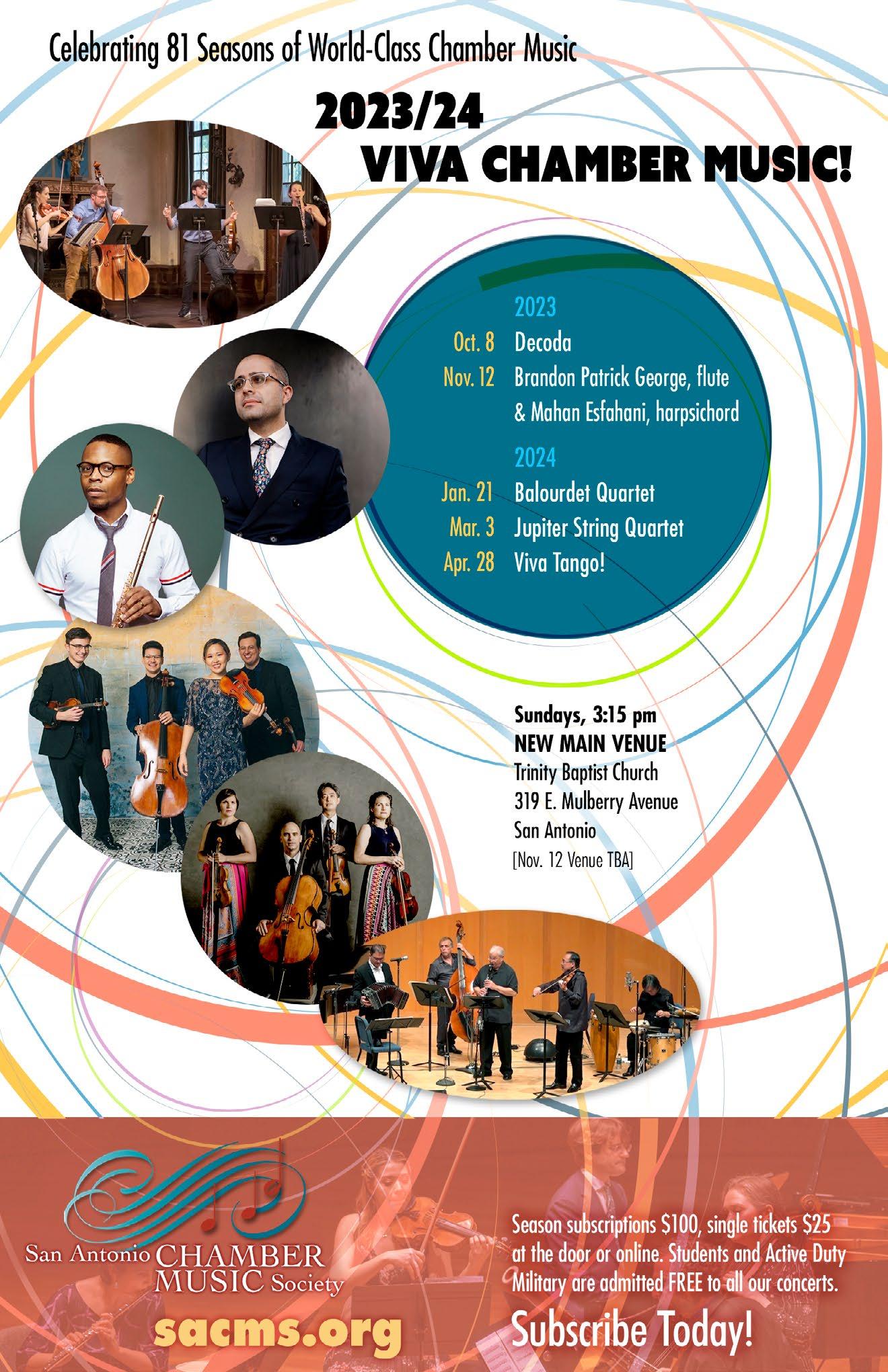

Emily Freudigman is Co-Founder of Camerata San Antonio. Emily holds degrees in viola performance from Southern Methodist University, the Peabody Conservatory, and the University of Michigan and has been a Fellow at the Tanglewood Music Center and the Aspen Music Festival and School. She has studied chamber music with members of the Juilliard, Muir, Concord and Tokyo String Quartets, and she has performed with the Grand Rapids, Maryland, Fort Worth and Boston Symphony Orchestras. Emily was the Assistant Principal Viola of the San Antonio Symphony from 2002 to 2019. She maintains an active viola studio in San Antonio – her students perform in the Texas All-State orchestras, attend prestigious summer music camps, including the Eastern and Killington Music Festivals and Interlochen Center for the Arts and have gone on to study at the Cleveland Institute of Music and Peabody Conservatory of Music.
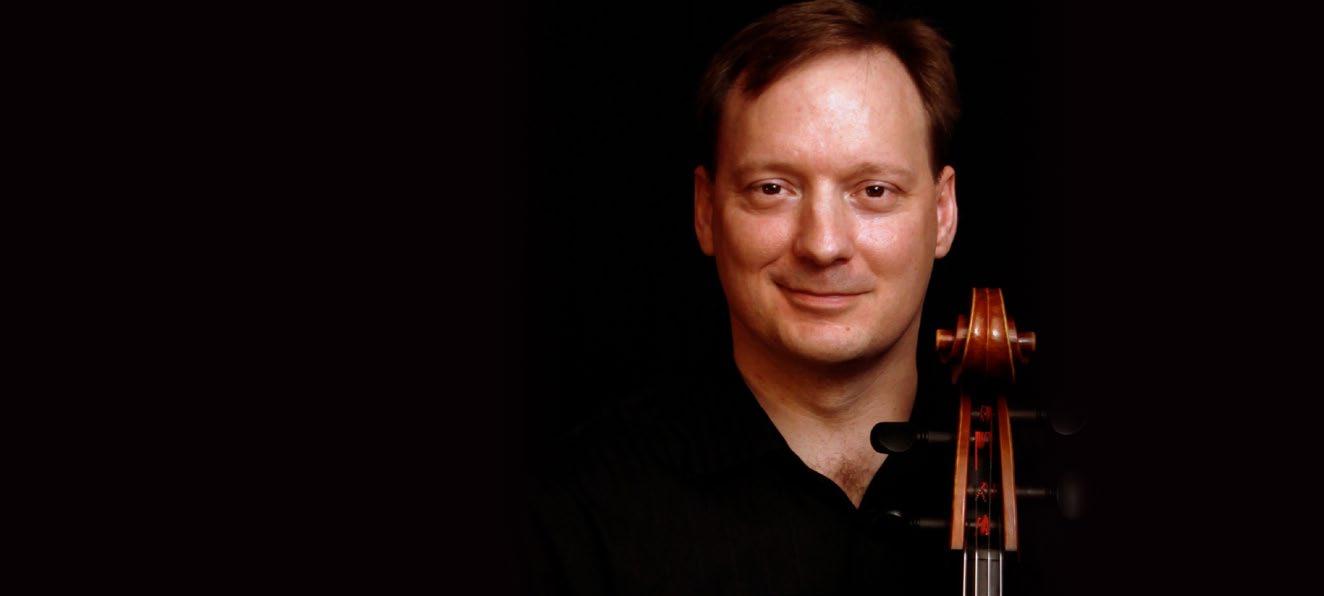
Kenneth Freudigman is Co-Founder and Artistic Director of Camerata San Antonio. Ken was Principal Cello of the San Antonio Symphony from 2004 to 2022 and continues in the role with the new San Antonio Philharmonic. A highlyrespected cello pedagogue, Ken also serves as Conductor of YOSA’s Symphony and Concertino Orchestras.
Mr. Freudigman began playing the violin at age six and found his true love, the cello, at the age of nine. After six years of study, he was accepted to attend the prestigious Interlochen Center for the Arts. Upon graduating with honors in music performance, he went on to receive a Bachelor of Music from the Eastman School of Music. He began his orchestral and chamber music career while at Eastman, winning a position with the Rochester Philharmonic and was also a founding member of the Esterhazy Chamber Ensemble. In 1992, Mr. Freudigman joined the New World Symphony, an advanced training orchestra for recent graduates of music schools, under the direction of Michael Tilson Thomas. He has also performed with the Atlanta, Utah, Grand Rapids, Charleston, and Virginia Symphony Orchestras, as well as the Sarasota Opera and the Mexico City Philharmonic. Mr. Freudigman was also a founding member of the American Sinfonietta.
His orchestra and chamber music engagements have taken him to the major concert halls of Europe, the Middle East, and throughout South and North America. Mr. Freudigman has performed chamber music with members of the Amadeus and Cleveland Quartets and with the pianist Jean-Yves Thibaudet. He has been a featured soloist with the World Youth and New World Symphony Orchestras, the San Antonio Symphony and the Mexico City Philharmonic, where he was engaged to perform Shostakovich’s First Cello Concerto. Mr. Freudigman can be heard in recordings on the Argo and Summit record labels, featured with Renee Fleming and the New World Symphony Orchestra performing Bachianas Brasileiras by Heitor Villa-Lobos on BMG Classics, and on Camerata San Antonio’s Grammy-nominated premiere CD, Salon Buenos Aires: Music of Miguel Del Aguila.

Originally from Long Island, New York, Laura Scalzo’s love of the violin was sparked by the great violinist, Itzhak Perlman, when she heard him play on “Sesame Street.” She began lessons at the age of 4 and has been playing ever since. She holds degrees from Temple University (BA) and the University of Delaware (MM). Her primary teachers have included William dePasquale, Xiang Gao, and Ellen dePasquale.
Ms. Scalzo joined the first violin section of the San Antonio Symphony in 2011. Ms. Scalzo is also the Assistant Concertmaster of the Mid-Texas Symphony. Before moving to San Antonio, she was a tenured member of the Delaware and Allentown Symphonies. As a passionate chamber music lover, Ms. Scalzo has performed with various ensembles in San Antonio, New York, Pennsylvania, and Delaware. She is currently a member of the Mid-Texas Chamber Players.
In addition to performing, Ms. Scalzo is an enthusiastic teacher and has maintained a private studio of all levels since 2000. At the University of Delaware, she was Xiang Gao’s teaching assistant and taught the undergraduate non-music majors. She was a professor of violin at Texas Lutheran University from 2013-2015.
Ms. Scalzo has many interests outside of music. In 2020 she launched a blog, www.rootsinthecitytx.com, where she shares her adventures in vegetable and native plant gardening. She is an avid animal lover and amateur chef. She can often be found at home in the kitchen cooking for family and friends, or when not working, attempting to entertain the cats.

Winner of the 2012 New Orleans International Piano Competition, Viktor Valkov has been hailed as a “lion of the keyboard” and “sensational” (Wiesbadener Kurier). A winner of Astral’s 2015 National Auditions, he recently gave a critically acclaimed recital in London’s Wigmore Hall, and appeared as soloist with the Louisiana Philharmonic Orchestra, Baton Rouge Symphony Orchestra, West Virginia Symphony Orchestra, and the Acadiana Symphony Orchestra.
Mr. Valkov has appeared frequently as a recitalist in the U.S., China, Japan, England, Norway, Germany, Italy, Greece, Bulgaria, and Macedonia.He debuted with the Sofia Philharmonic Orchestra, and performed Dimitar Nenov’s Grande Piano Concerto with New Symphony Orchestra under Rossen Milanov, becoming the fifth pianist to perform the concerto, and the only one to do so in its entirety. Mr. Valkov has made a number of recordings for the Bulgarian National Radio archive and has recorded for Bulgarian National Television and Macedonian Radio and Television.
Mr. Valkov’s concerts reflect a vast interest in chamber music as well as lesserknown piano repertoire. He frequently performs with Bulgarian cellist Lachezar Kostov. Both deeply interested in broadening the repertoire for cello/piano duo, they often include such composers as Kabalevsky, Roslavetz, Schnittke, and Saint-Saëns in their programs. In 2009, the Kostov-Valkov Duo gave its Carnegie Hall debut in Zankel Hall, and in 2011 won the Liszt-Garisson International Competition, where they were also awarded the Liszt Prize and special prizes in the collaborative artists category.
As a soloist, some of Mr. Valkov’s recent projects include Beethoven’s Hammerklavier sonata and Busoni’s Fantasia Contrappuntistica. He has presented a program highlighting composers of the 1600’s, including Froberger, Couperin, Frescobaldi, and Buxtehude, and selections from The Fitzwilliam Virginal Book. His first solo CD was a Naxos release of the complete piano music of Dimitar Nenov. Viktor Valkov is an Assistant Professor of Piano at the University of Utah.
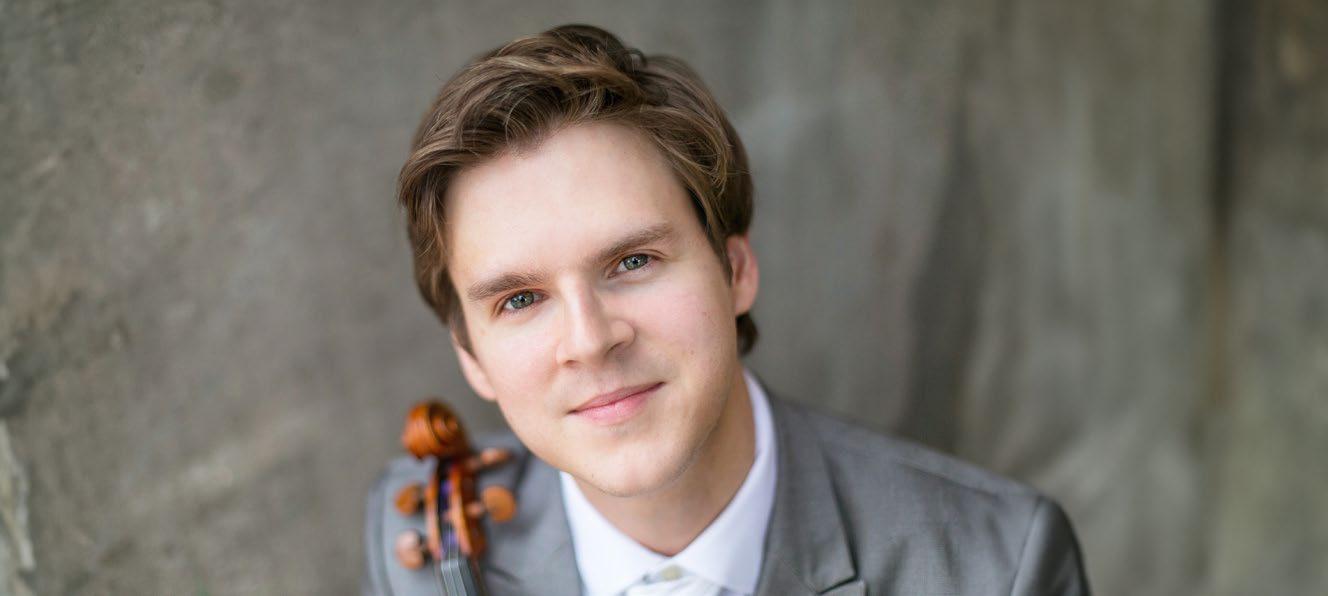
Matthew Zerweck (matthewzerweck.com) began his music studies at age 5, after watching Itzhak Perlman perform on the children’s television show, “Sesame Street.” After studying with several esteemed artist teachers, he entered the Eastman School of Music. He earned degrees from the Eastman School of Music (BM, MM), where he served as teaching assistant to the world renowned violinist and teacher, Charles Castleman.
Formerly the Assistant Concertmaster of the San Antonio Symphony (20082012), Matthew teaches violin full time in San Antonio. His students have played as soloists with the San Antonio Symphony, San Antonio Sinfonietta, and Starlight Symphony Orchestra. His students occasionally pursue music degrees at competitive colleges and conservatories.
An active performer, Matthew leads the San Antonio Sinfonietta as concertmaster and soloist. He’s also performed major concertos with the UIW Orchestra and Youth Orchestras of San Antonio. In 2015, he recorded the lead violin parts for “Upon the Awful Tree,” an independent film with an original score by Matt Dunne. In his free time, Matthew enjoys spending time with his wife, Nancy, his son, Charlie, and four cats.



Oct 23. 2023
Quartet for the End of Time
w/ Ani & Marta Aznavoorian cello & piano
Cahuzac • Ravel Messiaen
2023–2024
Season Concerts
MONDAYS
@ 7:30 pm
Mar 4. 2024
Celebrating March 8th, Internat’l Women’s Day
w/ Janice Carissa piano
Bonis • Tailleferre
Boulanger • Schumann Price
Jan 22. 2024
German Music of the Last Three Centuries
w/ John Novacek piano
Schroeder • Brahms Mozart • Jenner
info & tickets :
olmosensemble.com
location :
Shepherd King Lutheran Church
303 W. Ramsey Rd, San Antonio
May 6. 2024
Season Finale
Olmos Ensemble and Jon Nakamatsu
w/ Jon Nakamatsu piano
Haydn • Brahms
Beethoven • Blumer


Oct 5
Celebrate 100 years of passion and pomp!
Brahms–Elgar–Lalo–Grantham World Premiere for Schreiner Centennial
Dec 7
Musical moods of the holiday season!
Strauss–Tchaikovsky–Sing-Along Carols

Jan 6

Scenes, scents, and sounds of a night at the movies!
Mancine–Elfman–Williams–Movie Hits!
Feb 29
Leap forward in musical jubilation!
Verdi–Schumann–V. Williams–Spirituals

Apr 25

A celebration of musical fellowship!
Elgar–Pachelbel–Tchaikovsky


Introducing the Texas Violin Shop: Your Go-To Family-Owned Business in San Antonio. Come and experience our workshop, where we prioritize providing each customer with a positive and unique experience. From your very first student instrument to upgrading to a professional model, we've got you covered. Our selection of products is handpicked to meet our rigorous standards and cater to every budget.
At our company, we value community involvement and take pride in supporting local events and organizations that promote the arts. We strongly believe in the power of musi c to bring people together and are thrilled to be an active participant in San Antonio's thriving music scene.

Meet Samantha - a talented luthier and the owner of the only violin shop in San Antonio that creates handmade instruments in house.



KAY
VICE PRESIDENT
JULIE KENFIELD TREASURER
LISA FUENTES SECRETARY
JENNY FISH
SARA



FRIDAYS
KERRVILLE FIRST PRESBYTERIAN CHURCH 800 Jefferson St
Kerrville, TX 78028
SATURDAYS
EPISCOPAL CHURCH OF THE HOLY SPIRIT 11093 Bandera Rd
San Antonio, TX 78250
SUNDAYS
CHRIST EPISCOPAL CHURCH
510 Belknap Pl
San Antonio, TX 78212


Kenneth Bloom & Sheila Swartzman Charitable Trust
In memory of Kenneth Bloom
Dr. & Mrs. Thomas R. Hamilton
Sponsors of violinist
Matthew Zerweck and 2024 String Quartet Masterclass
The Agnes & Jim Lowe Fund
Didi & Alan Weinblatt
Sponsors of pianist Viktor Valkov
Dr. Donald K. Burda
City of San Antonio Department of Arts and Culture Events Grant
Mary Anne & Tony Crosby
Linda & Edgar Duncan
Ruth Ann Edney
Dr. & Mrs. Charles Goodhue
Barbara C. Kyse
Carl & Ann Leafstedt
Jeremy & Grace Phoa
San Antonio Symphony League
Janna Spurlock
Dr. Marion Worthington
ANONYMOUS (2)
Allegra Marketing Print Mail
Kay Lorraine Johnson & Scott Baird
Verna Benham
George Brin & Colleen Walter Brin
Julie Kenfield & Guy Clumpner
Liz Davenport
Forrest Family Charitable Fund
Garner Family Fund
Richard E. & Antonia K. Goldsmith
Phyllis Kline
Joe & Toni Murgo
Sara Ann Pomerantz
Wayne & Barbara Shore
Stephenson Family Gift Fund
Stratton Rehab
Sponsors of 2024 String Quartet Masterclass


Mary Ellen & Tim Summerlin
Texas Violin Shop
Sponsors of 2024 String Quartet Masterclass
Nancy S. Wallace and Edgar S. Wallace
Don & Barb Bentley
In honor of Joel Ramirez
Diane Burchers
Mike Greenberg
Junell Holmer
Helen Gail Jarratt
Frederica & Martin Kushner
Rosario Laird
Nickey McCasland
Phillips Family Charitable Fund
J. Scott Rose
Dr. Ana M. Valadez
ANONYMOUS (2)
Helga Anderson
Charles Bender
COL Frank Bertagnolli, (Ret)
Lisa & Wade Caldwell
Annelies Castro-Rios
Alan Cutler
Bernice Davis
Mike Davis
In honor of Toni Murgo
Arlene G. Dryer Giving Fund
Freda Flax
Paul Giolma
Pauline & Randolph Glickman
Delicia Herrera
Anne Johnson
Andrew Kania & Julie Post
Suzanne Kasanoff
Eunsu Lee
LuAnn Lockerbie
Hannah Margolis
Mimi McMillen
Lynne Noriskin
Daniel Rosenthal
Kathy & Robert Rothen
Dr. John Silantien
Kim Smith
Brik Stratton
Connie & Bruce Story
Carol Talpey
Irma Taute
Gustavo Valadez Ortiz
Gary & Jeanette Vaughan
Phil & Shirley Watkins
Florence Weinberg
Susan Weintraub
Tammy Widener
ANONYMOUS (5)
Stephen Amberg
Yanie Betts
Terence Brown
Marisa Bushman
Jacqueline Claunch
Laurel Donoho
Carol Duganne
Jenny Fish
Erwin Flores
Aaron & Ami Freudigman
Karen Freudigman
Ken & Emily Freudigman
Carol Frohlich
Lisa Fuentes
Kevin & Jennifer Garcia-Hettinger
Bethany Hirota-Mabry
Anya Grokhovski
Paul Gronquist
Margaret Hager
William Heffner
Linda Humphrey
Helen Gail Jarrett
Martha S. Jones
Julie Post & Andrew Kania
Kathleen Kemp
Mary Ann Kocurek
Mark Landson
Gregory McCarroll
Shaun McChesney
Marguerite McCormick
Edward McDuffie
Anne Mullen Smith
Eugene Oehler
Marilyn Respondek
Jose Rivas
Nancy & James Roberts
Tonja & Tim Rose
Mo & Brigitte Saidi
David Saussy
Cynthia J. Schwarz
Thor Sigurdson
Kathleen Sisco
Jack, Cara and Aaron Smith
In honor of Gary Mabry
Laurance Smith
Brittany Socher
Shannon Socher
Ann Springer
John Thompson
Kenneth Thompson
Art Thongpreecha
Beverly Valtierra
Elizabeth Velez
Mary Jane Verette
Jane Warsaw
Robert Weidman
Gillian Wiggins
Morgan Williams
Alice Witterman
John Woodworth


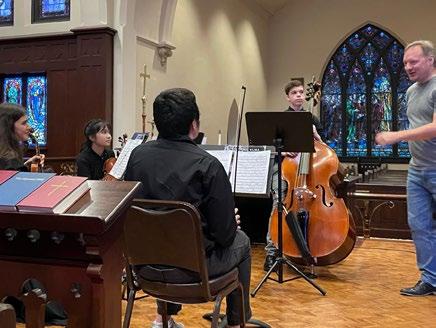




Please join us at one or both master classes to encourage the next generation of chamber musicians!
Camerata’s quartet is composed of artist-teachers who are dedicated to sharing their knowledge about the craft and art of music-making with area students. This spring, we are offering two free master classes (a lesson in front of an audience) for student chamber ensembles. During these classes, student groups perform a work they’ve already prepared to the best of their abilities, and our quartet helps them further along their path, highlighting details of ensemble-playing, non-verbal communication, and how to understand each player’s role in the work as a whole. The quartet’s many years of experience as chamber musicians and teachers makes this a uniquely impactful opportunity for area students.
MAY 13 6PM
FIRST UNITED METHODIST CHURCH
MAY 21 MAY 13
321 Thompson Dr, Kerrville, TX 78028
MAY 21 7PM
EPISCOPAL CHURCH OF THE HOLY SPIRIT
11093 Bandera Rd
San Antonio, TX 78250
Both classes are free to participants and observers thanks to the support of Dr. & Mrs. Thomas R. Hamilton, The Texas Violin Shop, Stratton Rehabilitation and The Episcopal Church of the Holy Spirit

Stay up-to-date on all Camerata San Antonio events. Be one of the first to find out what we’ve planned for the season!



The Camerata Compadres
Our Wonderful Volunteer Corps
BlackStone Studio
Barbara Holland
Bob Catlin
Christ Episcopal Church
The Rev. Dr. Patrick Gahan
RECTOR
Josh Benninger
DIRECTOR OF MUSIC
Jennifer Holloway
ASSISTANT DIRECTOR OF MUSIC
CEC Friends of Music
Episcopal Church of the Holy Spirit
Rev. Jason T. Roberts
RECTOR
Amanda LaHue
CHURCH ADMINISTRATOR
Gary Mabry
MUSIC MINISTER
Kerrville First Presbyterian Church
Rev. Jasiel Hernandez Garcia
SENIOR PASTOR
Seth Lafler
DIRECTOR OF CHORAL MUSIC
Sabrina Adrian ORGANIST
Worship Committee
Murgophonic
Jason Murgo
Traveling Blender
Sandy Weatherford
Texas Public Radio KPAC/KSTX
Barry Brake
Nathan Cone
Camerata San Antonio Artistic Director Kenneth Freudigman found clay in February of 2019 and has become obsessed with forms and glazes! When he’s not performing, teaching, conducting, biking, or running, you can find him making a mess in his ceramics studio!!



• WEBSITE: PrimocelloCeramics com
• INSTAGRAM: @primocello_ceramics
• FACEBOOK: www.facebook.com/PrimocelloCeramics

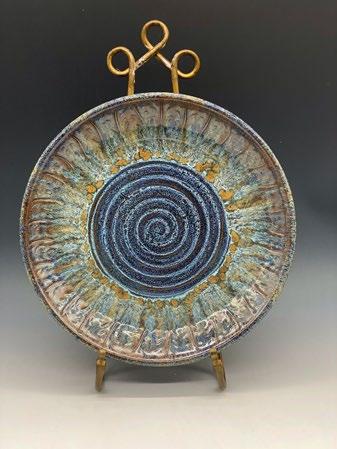

As the largest academic research institution in South Texas, we use the power of discovery, innovation and passion
to transform the health of our community.
See how we translate what we learn in our labs into hope for those we serve at EverythingItTakes.org.






